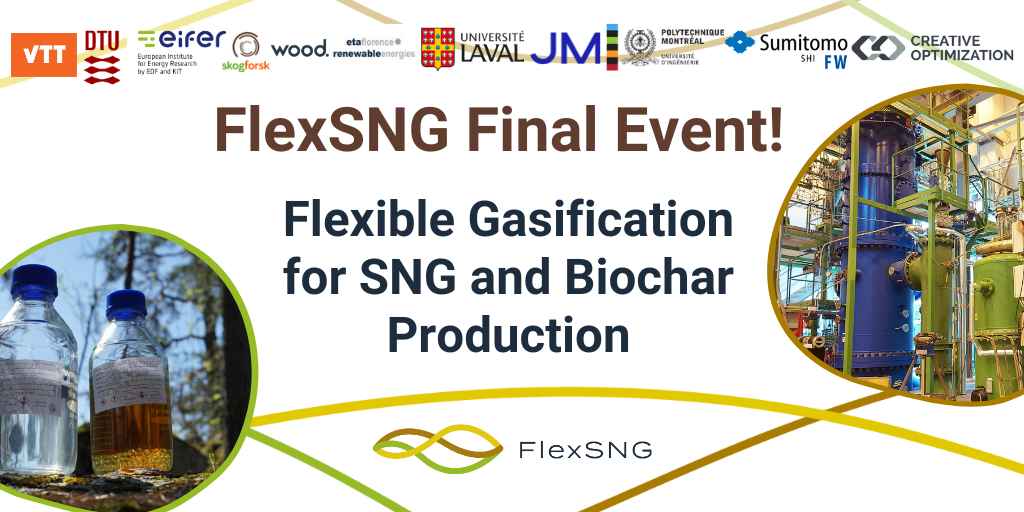The Final FlexSNG Event, held on December 2nd, marked the culmination of this groundbreaking project, which was originally set to conclude in May but received a 7-month extension until December to further its impactful research and innovation.
This closing event showcased cutting-edge solutions for the production of SNG and biochar, with key topics including the flexible gasification process, biochar markets, biomass supply chains, and industrial symbiosis case studies.
International partners such as VTT, DTU, EIFER, University of Montreal and others shared valuable insights into pioneering technologies for industrial gasification and methanation, underlining the potential of sustainable energy solutions.
The event drew an impressive audience of over 230 participants online, sparking dynamic discussions and generating a wealth of questions from an engaged and curious audience.
If you missed the Final FlexSNG event, or you’d like to relive the highlights, the full recording is available here: https://youtu.be/NAp8qTnmAlA.
For those interested in the Q&A session, a recap of all the questions and answers can be found here:
1. How much energy is required to achieve the 900 degrees C° temperatures?
Both the gasifier and the refomer are adiabatic reactors. Here the required temperature levels are achieved by using oxygen feeding. Thus, part of feedstock energy is converted into chemical energy and part to enthalpy. Entalphy is the used to generate steam and hot water. Thus we have to look the overall efficiencies of the process. Feedstock is combusted (oxygen feeding in gasifier) to produce energy for heat and endothermic reactions.
2. What is the pressure in the gasifier during the tests?
Gasifier was operated near athmospheric pressure. <0,5 bar
3. Have you tested wood chips instead of wood pellets?
In FlexSNG we utilized pelletized feedstocks, mainly to avoid any disturbances in fuel feeding. In previous projects wood chips, forerest residues and bark have been successfully gasified without prior pelletizing.
4. Why do you feed N2 into the catalytic reformer? N2 is difficult to remove in the downstream process
We do not need N2 in industrial plants. In our pilot plant we have N2 purging which dilutes the gas. In an industrial reformer, we wouldn’t use N2 but steam instead. This is related to the restrictions of the pilot plant instead as we currently don’t have steam feed to the first stage of the reformer.
5. What has prevented you from using just crushed resinous from the debarking process in saw mills?
Industrial plants do not require pelletizing if low-pressure gasification is applied. In our small pilot plant pellets simplify the fuel feeding. Pellets were used in the pilot only to ensure stable feeding into the gasifier.
6. Did you measure the composition of tar? What is the main component, benzene?
Tars were measure both after filter and after the reformer. Benzene is the most abundant compound, followed by naphthalene.
7. Is benezene or naphthalne a more problematic compound for the dowstream process?
Yes, but in FlexSNG oxygen transfer membranes were in research focus.
8. As you don’t have any solid medium in the gasifier, have you observed fluidization issues within the BFB due to different particle size distributions ?
That was only related to the BCFB gasifier concept when we were attempting to recover the biochar product as bottom ash. Solid medium was used in all other gasification tests and in the CFB gasifier. But it is true that fluidisation might be tricky when operating with biochar bed only. However, the testing periods were fairly limited in this operation mode so we didn’t experience too big issues during this short period.
The BFB operation without sand/dolomite was more challenging than BFB or CFB with a stabilizing bed material. Thus we selected CFB where we always use also bed materials.
9. Did you use dolomite as bed material or did you test other materials also? In case bed material was calcium based, did you have agglomeration formation problems caused by calcium calsination-recarbonation in certain temperature range?
We have tested various bed materials including sand and dolomite. Basically we do not have problems related to calcination-recarbonation when we operate at close to atmospheric-pressure. At above 4-5 bat these issues become problematic and we have replace calcium by other alternatives.
10. How does the methanation of cleanse gas work? What is the reactor?
Methanation of FlexSNG project is based on WOOD VESTA catalytic methanation based on fixed bed reactors. We will deepen the once through process of VESTA methanation in the last session of the webinar.
11. What was the software used?
The feedstock supply chain optimization was Woodflow/Bioflow by Creative Optimization.


